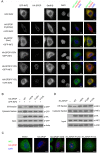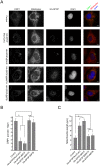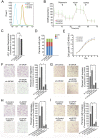Dysregulation of INF2-mediated mitochondrial fission in SPOP-mutated prostate cancer
- PMID: 28448495
- PMCID: PMC5426793
- DOI: 10.1371/journal.pgen.1006748
Dysregulation of INF2-mediated mitochondrial fission in SPOP-mutated prostate cancer
Abstract
Next-generation sequencing of the exome and genome of prostate cancers has identified numerous genetic alternations. SPOP (Speckle-type POZ Protein) was one of the most frequently mutated genes in primary prostate cancer, suggesting SPOP is a potential driver of prostate cancer development and progression. However, how SPOP mutations contribute to prostate cancer pathogenesis remains poorly understood. SPOP acts as an adaptor protein of the CUL3-RBX1 E3 ubiquitin ligase complex that generally recruits substrates for ubiquitination and subsequent degradation. ER-localized isoform of the formin protein inverted formin 2 (INF2) mediates actin polymerization at ER-mitochondria intersections and facilitates DRP1 recruitment to mitochondria, which is a critical step in mitochondrial fission. Here, we revealed that SPOP recognizes a Ser/Thr (S/T)-rich motif in the C-terminal region of INF2 and triggers atypical polyubiquitination of INF2. These ubiquitination modifications do not lead to INF2 instability, but rather reduces INF2 localization in ER and mitochondrially associated DRP1 puncta formation, therefore abrogates its ability to facilitate mitochondrial fission. INF2 mutant escaping from SPOP-mediated ubiquitination is more potent in prompting mitochondrial fission. Moreover, prostate cancer-associated SPOP mutants increase INF2 localization in ER and promote mitochondrial fission, probably through a dominant-negative effect to inhibit endogenous SPOP. Moreover, INF2 is important for SPOP inactivation-induced prostate cancer cell migration and invasion. These findings reveal novel molecular events underlying the regulation of INF2 function and localization, and provided insights in understanding the relationship between SPOP mutations and dysregulation of mitochondrial dynamics in prostate cancer.
Conflict of interest statement
The authors have declared that no competing interests exist.
Figures









Similar articles
-
Destruction of DDIT3/CHOP protein by wild-type SPOP but not prostate cancer-associated mutants.Hum Mutat. 2014 Sep;35(9):1142-51. doi: 10.1002/humu.22614. Epub 2014 Jul 23. Hum Mutat. 2014. PMID: 24990631
-
SPOP promotes ATF2 ubiquitination and degradation to suppress prostate cancer progression.J Exp Clin Cancer Res. 2018 Jul 11;37(1):145. doi: 10.1186/s13046-018-0809-0. J Exp Clin Cancer Res. 2018. PMID: 29996942 Free PMC article.
-
Endometrial cancer-associated mutants of SPOP are defective in regulating estrogen receptor-α protein turnover.Cell Death Dis. 2015 Mar 12;6(3):e1687. doi: 10.1038/cddis.2015.47. Cell Death Dis. 2015. PMID: 25766326 Free PMC article.
-
The ubiquitin ligase adaptor SPOP in cancer.FEBS J. 2019 Oct;286(20):3946-3958. doi: 10.1111/febs.15056. Epub 2019 Sep 18. FEBS J. 2019. PMID: 31495053 Free PMC article. Review.
-
The emerging role of speckle-type POZ protein (SPOP) in cancer development.Drug Discov Today. 2014 Sep;19(9):1498-502. doi: 10.1016/j.drudis.2014.07.009. Epub 2014 Jul 21. Drug Discov Today. 2014. PMID: 25058385 Free PMC article. Review.
Cited by
-
Role of actin-binding proteins in prostate cancer.Front Cell Dev Biol. 2024 Jul 11;12:1430386. doi: 10.3389/fcell.2024.1430386. eCollection 2024. Front Cell Dev Biol. 2024. PMID: 39055653 Free PMC article. Review.
-
SPOP in Cancer: Phenomena, Mechanisms and Its Role in Therapeutic Implications.Genes (Basel). 2022 Nov 7;13(11):2051. doi: 10.3390/genes13112051. Genes (Basel). 2022. PMID: 36360288 Free PMC article. Review.
-
Cancer-associated SPOP mutations enlarge nuclear size and facilitate nuclear envelope rupture upon farnesyltransferase inhibitor treatment.J Clin Invest. 2025 Jul 15;135(14):e189048. doi: 10.1172/JCI189048. eCollection 2025 Jul 15. J Clin Invest. 2025. PMID: 40662365 Free PMC article.
-
Prostate cancer-associated SPOP mutations lead to genomic instability through disruption of the SPOP-HIPK2 axis.Nucleic Acids Res. 2021 Jul 9;49(12):6788-6803. doi: 10.1093/nar/gkab489. Nucleic Acids Res. 2021. PMID: 34133717 Free PMC article.
-
LZTR1: A promising adaptor of the CUL3 family.Oncol Lett. 2021 Jul;22(1):564. doi: 10.3892/ol.2021.12825. Epub 2021 May 29. Oncol Lett. 2021. PMID: 34113392 Free PMC article. Review.
References
MeSH terms
Substances
LinkOut - more resources
Full Text Sources
Other Literature Sources
Medical
Miscellaneous

